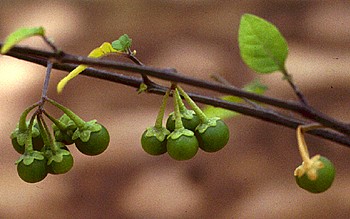 Photo: D.E. Symon © D.E. Symon |
 Line drawing by M. Szent Ivany, J. Adelaide Bot. Gard. 4 (1981) 41, fig. 2. |
 Distribution map generated from Australia's Virtual Herbarium. |

Synonymy
Solanum opacum A. Braun & Bouché, Index Sem. Hort. Berol. App. 8: 18, no. 39 (1853)
T: Cultivated at Berlin Botanical Gardens from seeds from Australia, Listeman; holo: B, destroyed; Broad Sound, Sept. 1802, R. Brown; neo: NSW 125341; iso: K, MEL, fide R.J.F. Henderson, Contr. Queensland Herb. 16: 39 (1974).
[S. nigrum auct. non L.; G. Bentham, Fl. Austral. 4: 446 (1869) p.p.]
Description
Sprawling, almost prostrate annual herb to 1 m diam., green, pubescent with minute glandular and simple non-glandular hairs; prickles absent.
Leaves ovate-lanceolate; lamina 3–6 cm long, usually 1–2 cm wide, concolorous, usually shallowly lobed; petiole 1–4 cm long.
Inflorescence 2–5–flowered; peduncle 15–20 mm long; rachis 2–3 cm long; pedicels 7–10 mm long. Calyx 2–3 mm long; lobes rounded or broadly triangular, to 1 mm long. Corolla stellate, 8–12 mm diam., white. Anthers 1.5–2 mm long.
Berry globular, 8–10 mm diam., green when ripe. Seeds 1.8–2.2 mm long, pale fawn tinged with green. Stone-cell granules 0.8 mm diam. n=36.
A more comprehensive description can be found at http://delta-intkey.com/solanum/www/opacum.htm
Distribution and ecology
Occurs in eastern Australia from northern Qld to Tas. and south-eastern S.A. Also in PNG. The spread of this weed is quite noticeable since it was last mapped in Symon (1981).
Grows in wetter areas along creeks, rainforest clearings and open eucalypt woodland, usually in red earths and shales.
Common name
Green-berry Nightshade
Relationships
Part of the S. nigrum or "Black nightshade" group of species, usually referred to as cosmopolitan weeds and usually thought to have originated in the Americas. They are characterised by their lack of prickles and stellate hairs, their white flowers and their green or black fruits arranged in an umbelliform fashion.
The species can be difficult to distinguish. Other species to occur in Australia are S. americanum, S. chenopodioides, S. furcatum, S. nigrum, S. douglasii, S. physalifolium, S. retroflexum, S. sarrachoides, S. scabrum and S. villosum.
A useful reference to the Black Nightshades is J. M. Edmonds & J. A. Chweya, The Black Nightshades. Solanum nigrum and its related species. Int. Plant. Genetic Res. Inst. Rome (1997).
Notes
Collected by Banks and Solander from Botany Bay in 1770 and also by Robert Brown in the early 1800s from Sydney and from Broad Sound in Qld.
Selected specimens
S.A.: Upper Murray River, D.E. Symon 11586 (AD). Qld: Brisbane, 24 Jan. 1965, H.E. Kleinschmidt (BRI). N.S.W.: Griffith district, Apr. 1943, L. Fraser (NSW). Vic.: near Tubbut, A.C. Beauglehole 33110 (MEL). Tas.: near Bell Bay, R.C. Gunn 51/1842 (HO).
Plant status, if any
Listed as an endangered species for Tasmania - see www.dpiw.tas.gov.au/inter.nsf/Attachments/SSKA-76P33E/$FILE/Solanum%20opacum.pdf
Without national listing under the EPBC act.
From the web
Further information on this species in NSW can be seen on the PlantNET site and in SA on the eFlora SA site.
Limited information for this species can be found on the Solanaceae Source site.